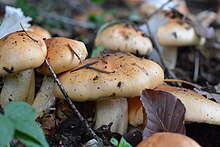| Hygrophorus pudorinus | |
|---|---|

| |
| Scientific classification | |
| Domain: | Eukaryota |
| Kingdom: | Fungi |
| Division: | Basidiomycota |
| Class: | Agaricomycetes |
| Order: | Agaricales |
| Family: | Hygrophoraceae |
| Genus: | Hygrophorus |
| Species: | H. pudorinus |
| Binomial name | |
| Hygrophorus pudorinus (Fr.) Fr. (1836) | |
| Synonyms | |
| |
Hygrophorus pudorinus, commonly known as the blushing waxycap, turpentine waxycap, or spruce waxy cap, is a species of fungus in the genus Hygrophorus.
Swedish mycologist Elias Magnus Fries described it as Agaricus pudorinus in his 1821 work Systema Mycologicum. It became Hygrophorus pudorinus with the raising of Hygrophorus to genus rank. The species name is the Latin word pudorinus "blushing".
The species is classified in the subsection Pudorini of genus Hygrophorus, along with the closely related species H. erubescens and H. purpurascens.
The fruit body (mushroom) is a fair size, with a 5–12 cm (2–4+3⁄4 in) diameter pink to golden convex cap with a downrolled margin that is lighter in colour. The cap surface is sticky. The pink to yellow-white gills are decurrent. The thick stipe is 4–16 cm (1+5⁄8–6+1⁄4 in) tall and 1–3 cm (3⁄8–1+1⁄8 in) wide. The spore print is white and the oval spores measure 7–10 × 5–6 micrometres. The thick flesh is pale pink or orange to white. The mushroom does not bruise red and has no distinctive odour, though it can taste like turpentine.
Hygrophorus pudorinus is found in coniferous woodlands under fir and spruce trees across western and northeastern North America; it is particularly common in Canada and the Rocky Mountains. The mushrooms appear in groups or fairy rings in late summer and autumn. They often grow in boggy places in sphagnum moss.
Despite its taste, it is edible after cooking. Its variable appearance makes identification difficult and hence raises risk of misidentification.
References
Species of fungus| Hygrophorus pudorinus | |
|---|---|
| Gills on hymenium | |
| Cap is convex | |
| Hymenium is adnate or decurrent | |
| Stipe is bare | |
| Spore print is white | |
| Edibility is edible | |
- ^ McKnight KH, Peterson RT, McKnight VB (1998). A Field Guide to Mushrooms: North America. Houghton Mifflin Harcourt. p. 209. ISBN 9780395910900.
- ^ Bessette A, Bessette AR, Fischer DW (1997). Mushrooms of Northeastern North America. Syracuse University Press. p. 143. ISBN 978-0-8156-0388-7.
- Arora, David (1986). Mushrooms demystified: a comprehensive guide to the fleshy fungi (Second ed.). Berkeley: Ten Speed Press. ISBN 978-0-89815-169-5.
- "Hygrophorus pudorinus (Fr.) Fr". MycoBank. International Mycological Association. Retrieved 1 November 2015.
- Fries EM. (1821). Systema Mycologicum (in Latin). Vol. 1. Lund: Ex Officina Berlingiana. p. 33.
- ^ Evenson VS. (1997). Mushrooms of Colorado and the Southern Rocky Mountains. Westcliffe Publishers. p. 68. ISBN 978-1-56579-192-3.
- Lodge DJ; et al. (2014). "Molecular phylogeny, morphology, pigment chemistry and ecology in Hygrophoraceae (Agaricales)" (PDF). Fungal Diversity. 64 (1): 1–99 (see p. 64). doi:10.1007/s13225-013-0259-0. S2CID 220615978. [REDACTED]
- Davis, R. Michael; Sommer, Robert; Menge, John A. (2012). Field Guide to Mushrooms of Western North America. Berkeley: University of California Press. p. 130. ISBN 978-0-520-95360-4. OCLC 797915861.
- ^ States J (1990). Mushrooms and Truffles of the Southwest. University of Arizona Press. p. 66. ISBN 9780816511921.
| Taxon identifiers | |
|---|---|
| Hygrophorus pudorinus | |
| Agaricus pudorinus | |